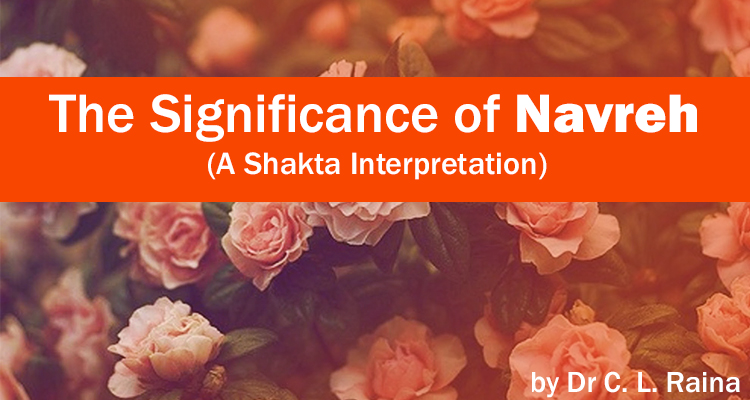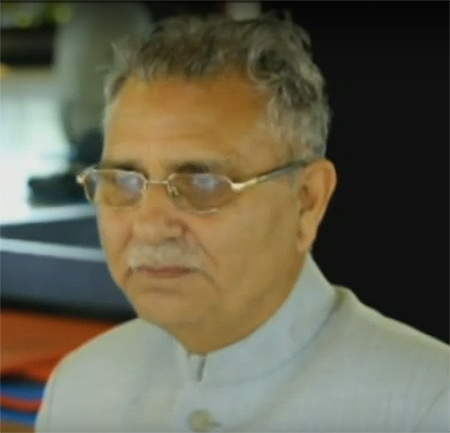

The Significance of Navreh
(A Shakta Interpretation)
by Dr C. L. Raina
Kashmiri Pandits celebrate their New Year’s Day, Navreh, on Chaitra Shukla Pratipada or the first day of the bright fortnight of the month of Chaitra. The word ‘Navreh’ is derived from Sanskrit ‘Nava Varsha’ meaning the New Year. On the eve of Navreh, which falls on Amavasya or the last night of the dark fortnight, they keep a thali filled with rice, a cup of curds, a bread, cooked rice, some walnuts, an inkpot and a pen, a silver coin and the Panchanga of the New Year, as the first thing to be seen at the Brahma Muhurta or the wee hours. The Panchanga popularly known as Nechi Patri (Nakshatra Patri) is an almanac giving important astrological configurations and auspicious tithis or dates and other useful religious information for the coming year. Keeping the Nechi Patri handy for consultation is a tradition followed in every Kashmiri Pandit household where religious and even social obligations are performed according to the tithis, mathematically calculated in it.
This Navreh, the Saptarishi era followed by the Kashmiri Pandits is entering its 5075th year (falling on 18th March of the Christian calendar). Imagine for a while the perfection with which such a span of time had been calculated by their ancestors to the minutest of minute unit of time pala, vipala etc. with the help of their knowledge of jyotishya and phalit shastra. The Navreh Mavas, or the concluding day of the year is to be succeeded by the Pratipada or the first Navaratra. In mathematics 1,2,3,4,5,6,7,8,9 are natural numbers. Then there is zero or shunya. Shunya is nothingness, but it is also the param bindu of the Nava Durga, meditated upon at the sandhi or conduction of Amavasya and Pratipada. Symbolically, the Nava Durgas are the nine fold projections of the supreme-self, which can be observed in the Shrichakra or Shri Yantram at the Sharika Parvat in Kashmir.
On the sacred Pratipada day the ishta devi is invoked with the dhyana mantra and the bija mantra while having the first look at the Nakshatra Patri or Panchanga. That is why the Kashmiri Pandits used to go the Sharika Parvat (Hari Parvat) and pay their obeisance at the Chakreshwara, reciting the Bhavani
Sahasranama, Indrakshi and other Devi Strotras and praying for prosperity for the new year in an auspiciousness sufused with karma, jnana and bhakti. That is what the primary triangle of the Chakreshwara stands for. The Primary triangle according to the Saptashati Hridayam denotes the interaction between the nada and the hindu. It is the eternal seed filled with the primal vibration of Aum or Aim. It sports, gets multiplied, assumes names and forms and sustains for kalpas or aeons together, then reverts back to the moola bindu or the original bindu, which is nirakara or formless.
The Shakti worshipers of Kashmir see all the facets of Shri Chandi in Shri Sharika whose divine presence fills every syllable of the sixteen-syllabled bija mantra at Chakreshwara.
They find in it eternal vibrations of Shiva and Shakti presented by geometrical configuration. The dots, angle, triangle, straight line, intersection of curves forming petals and outer squares are but concepts denoting manifestation of Shakti in the external Universe. To realise Shakti within oneself, the Kashmir Shaktas pray to the matrikas – the phonenes of the mantras — to vibrate and re-vibrate from Pratipada to mahanavmi. The Navdurgas or the nine facets of Durga are visualised as Shailaputri Brahmakumari, Chandraghanta, Kushmanda, Skandamata, Katyayani, Kalaratri, Mahagauri and Siddhidhatri put in an ascending order. This order symbolises the journey through consciousness or chaitanya.
So when the first ray of the sun descends on the earth on Chaitra Shukla Pratipada, the Kashmiri Pandits celebrate the presence of Durga, the Supreme Mother among them as Navreh, the New Year’s Day.
Note- Article publishing permission granted by Dr Chaman Lal Raina
